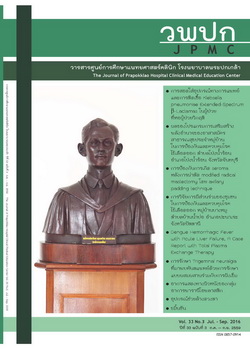การป้องกันการเกิด seroma หลังการผ่าตัด modified radical mastectomy โดย axillary padding technique
Main Article Content
Abstract
ที่มาของปัญหา: closed suction drainage เป็นวิธีปกติที่ใช้ในการป้องกันการเกิด seroma หลังการผ่าตัด modified radical mastectomy (MRM) ระยะเวลาในการใส่ท่อระบายมักจะยาวนาน ทำให้เกิดความไม่สุขสบายกับผู้ป่วย และบางครั้งทำให้เกิดความล่าช้าในการได้รับ adjuvant therapy ผู้ศึกษานำเสนอวิธีเย็บปิดแผล MRM ด้วย axillary padding technique โดยไม่ใส่ท่อระบายซึ่งเป็นอีกวิธีหนึ่งที่ได้ผลในการป้องกันการเกิด seroma
วัตถุประสงค์: การศึกษานี้ทำขึ้นเพื่อประเมินประสิทธิภาพของ axillary padding technique ในการป้องกันการเกิด seroma
วัสดุและวิธีการ: ระหว่างวันที่ 1 เดือนตุลาคม พ.ศ. 2552 ถึงวันที่ 30 เดือนกันยายน พ.ศ. 2557 ผู้ป่วยมะเร็งเต้านมในระยะต่างๆ 221 ราย ได้รับการผ่าตัด MRM โดยเย็บปิดแผลด้วย axillary padding technique และไม่ใส่ท่อระบาย หลังผ่าตัดมีการติดตามอุบัติการณ์ของการเกิด seroma และจำนวนวันนอนโรงพยาบาล
ผลการศึกษา: มี seroma เกิดขึ้น 6 ราย (ร้อยละ 2.71) จำนวนวันนอนเฉลี่ย 3.072 วัน
สรุป: การเย็บปิดแผล MRM ด้วย axillary padding เป็นอีกวิธีหนึ่งที่ได้ผลดีในการป้องกันการเกิด seroma
คำสำคัญ : seroma, mastectomy, axillary drain, breast cancer, axillary padding flap fixation.
Prevention of Seroma Formation after Modified Radical Mastectomy by Axillary Padding Technique
Background: Closed suction drainage is a usual method for prevention of seroma formation after modified radical mastectomy. The drainage period is usually prolonged and results in patient’s discomfort and sometimes causes delay in receiving adjuvant therapy. The author describes the use of axillary padding technique without drain as an effective alternative method.
Objective: The aim of this study was to evaluate the effectiveness of axillary padding technique in prevention of seroma formation in patients who underwent modified radical mastectomy (MRM).
Materials and Methods: Between October 1, 2009 – September 30, 2014, 221 female patients with various stages of breast cancer underwent MRM with axillary padding technique without drain. The postoperative occurrence of seroma and length of hospital stay were assessed.
Results: Seroma occurred in 6 patients (2.71 percent). The average length of hospital stay was 3.072 days.
Conclusions: Axillary padding is an effective alternative method for prevention of seroma formation after meodified radical mastectomy.
Keywords: seroma, mastectomy, axillary drain, breast cancer, axillary padding flap fixation.
